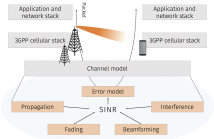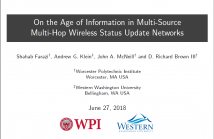
- Read more about Artificial Interference Aided Physical Layer Security in Cache-enabled Heterogeneous Networks
- Log in to post comments
- Categories:
 3 Views
3 Views
- Read more about On the tradeoff between rate and pairwise error performance of Alamouti and SP(2) space-time block codes
- Log in to post comments
- Categories:
 22 Views
22 Views
- Read more about A Constant-Gap Result on the Multi-Antenna Broadcast Channels with Linearly Precoded Rate Splitting
- Log in to post comments
In this paper, we consider a simple downlink channel with a multi-antenna base station and two single-antenna receivers. We assume that the channel is deterministic and known to all the nodes. Our contribution is two-fold. First, we show that linear precoding with private streams can have unbounded gap to the capacity of the channel. Second, we show that using rate-splitting with a simple power allocation one can achieve the sum capacity to within a constant gap for any channel realization.
- Categories:
 8 Views
8 Views
- Read more about User Scheduling in Massive MIMO
- Log in to post comments
Massive MIMO relies on nearly orthogonal user channels to achieve unprecedented spectral efficiency. But in LoS (line-of-sight) environment, some users can be subjected to similar channel vectors. Serving users with similar channel vectors simultaneously can severely compromise the throughput performance to all users. We propose a scheduler that identifies users with similar channels and serves them in separate time slots with properly assigned data rates, while aiming to provide fair service to all users and maximize the system spectral efficiency at the same time.
- Categories:
 192 Views
192 Views
- Read more about Ultrasonically Rechargeable Platforms for Closed-Loop Distributed Sensing and Actuation in the Human Body
- Log in to post comments
- Categories:
 2 Views
2 Views
- Read more about Mobile App User Choice Engineering using Behavioral Science Models
- Log in to post comments
When interacting with mobile apps, users need to take decisions and make certain choices out of a set of alternative ones offered by the app. We introduce optimization problems through which we engineer the choices presented to users so that they are nudged towards decisions that lead to better outcomes for them and for the app platform. User decision-making rules are modeled by using principles from behavioral science and machine learning.
- Categories:
 6 Views
6 Views
- Read more about Impact of Channel Models on the End-to-End Performance of mmWave Cellular Networks
- Log in to post comments
Communication at mmWave frequencies is one of the major innovations of the fifth generation of cellular networks, because of the potential multi-gigabit data rate given by the large amounts of available bandwidth. The mmWave channel, however, makes reliable communications particularly challenging, given the harsh propagation environment and the sensitivity to blockage. Therefore, proper modeling of the mmWave channel is fundamental for accurate results in system simulations of mmWave cellular networks.
spawc-poster-v1.pdf
- Categories:
 38 Views
38 Views
- Read more about Adaptive Mode Switching Algorithm for Dual Mode SWIPT with Duty Cycle Operation
- Log in to post comments
In this paper, we design a self-powering dual mode simultaneous wireless information and power transfer (SWIPT) system in which a sensor node adaptively controls single tone or multi-tone communication mode. To this end, we introduce duty cycle operation for the dual mode SWIPT with self-powering, which considers nonlinear energy harvesting (EH) model for both single tone and multi-tone waveforms. We formulate an adaptive mode switching (MS) problem which maximizes the achievable rate under the energy causality condition.
- Categories:
 10 Views
10 Views
- Read more about Statistical Analysis of EH Battery State under Noisy Energy Arrivals
- Log in to post comments
- Categories:
 9 Views
9 Views
- Read more about On the Age of Information in Multi-Source Multi-Hop Wireless Status Update Networks
- Log in to post comments
This paper studies a multi-source “age of information”
problem in multi-hop wireless networks with packetized
status updates and explicit channel contention. Specifically, the
scenario considered in this paper assumes that each node in the
network is a both a source and a monitor of information. Nodes
take turns broadcasting their information to other nodes in the
network while also maintaining tables of status updates for the
information received from all other nodes in the network. Lower
- Categories:
 126 Views
126 Views